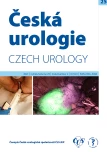Antibiotic prophylaxis in multiparametric magnetic resonance imaging-guided transrectal prostate biopsy
Authors:
Jakub Řezáč 1; Otakar Čapoun 1; Roman Sobotka 1; Lenka Kupidlovská 2; Lukáš Lambert 3
; Petr Hanuš 3; Iva Macová 3; Vladimír Černý 3; Tomáš Hanuš 1
Authors‘ workplace:
Urologická klinika VFN a 1. LF UK v Praze
1; Ústav lékařské biochemie a laboratorní diagnostiky VFN, Klinická mikrobiologie a ATB centrum, Praha
2; Radiodiagnostická klinika VFN a 1. LF UK v Praze
3
Published in:
Ces Urol 2021; 25(2): 106-111
Category:
Original Articles
Overview
Řezáč J, Čapoun O, Sobotka R, Kupidlovská L, Lambert L, Hanuš P, Macová I, Černý V, Hanuš T. Antibiotic prophylaxis in multiparametric magnetic resonance imaging-guided transrectal prostate biopsy.
Introduction: Antibiotic prophylaxis is, according to international recommendations, an integral part of transrectal prostate biopsy. The most used antibiotics are ciprofloxacin and cotrimoxazole. However, the incidence of resistance to both substances has an upward trend. The aim of our work was to evaluate the microbial profile from a rectal swab and to determine the sensitivity of bacterial strains in patients indicated for multiparametric magnetic resonance imaging-guided prostate biopsy.
Material and methods: In the period from 03/2019 to 05/2020, we examined a total of 192 patients. Prophylactically, cotrimoxazole 960 mg p. o. every 12 hours in a total of three doses starting in the morning on the day of the biopsy was most administered. In case of allergy, we recommended ciprofloxacin 750 mg p. o. in the same regime. We performed a rectal swab just before the procedure. Bacterial strains were cultured on common soils, sensitivity was determined qualitatively by the diffusion disk method. We recorded a maximum of three strains and, in the case of resistance, all evaluated antibiotics. We prospectively monitored the occurrence of a septic reaction, characterized by a general alteration of the condition, a temperature above 38 °C and a painful per rectum finding requiring hospitalization within seven days after the procedure.
Results: A total of 266 bacterial strains were found in a total of 170 (88.5 %) patients. The most frequently cultured strain was Escherichia coli with sensitivity to all antibiotics (45.8 % of all patients). Most often, we described Escherichia coli resistance to potentiated aminopenicillin (22 % of strains). Resistance to cotrimoxazole and ciprofloxacin, respectively, was observed in 19 % and 22 % strains, respectively. Resistance to three or more antibiotics has been described in 27 strains. Septic complication occurred in a total of three (1.6 %) patients, we present those in short case reports.
Conclusion: Our results show a similar incidence of pathogens resistant to both commonly used antibiotics. Despite the relatively high incidence of resistance, the number of clinical complications remains low.
Keywords:
antibiotics – Biopsy – Prophylaxis – prostate cancer
Sources
1. EAU Guidelines Prostate Cancer [cit. 27.2.2021]. Dostupné z: https://uroweb.org/guideline/prostate-cancer.
2. Kandil H, Cramp E, Vaghela T. Trends in Antibiotic Resistance in Urologic Practice. Eur Urol Focus 2016; 2: 363–373.
3. Cai T, De Nunzio C, Andrea Salonia A, et al. Urological infections due to multidrug-resistant bacteria: what we need to know? Urologia 2016; 83(1): 21–26.
4. Elshal AM, Atwa AM, El-Nahas AR, et al. Chemoprophylaxis during transrectal prostate needle biopsy: critical analysis through randomized clinical trial. World J Urol 2018; 36(11): 1845–1852.
5. European Medicines Agency [cit. 27.2.2021]. Dostupné z: https://www.ema.europa.eu/en/medicines/ human/referrals/quinolone-fluoroquinolone-containing-medicinal-products.
6. Roberts MJ, Bennett HY, Harris PN, et al. Prostate Biopsy-related Infection: A Systematic Review of Risk Factors, Prevention Strategies, and Management Approaches. Urology 2017; 104: 11–21.
7. Pepe P, Aragona F. Morbidity after transperineal prostate biopsy in 3000 patients undergoing 12 vs 18 vs more than 24 needle cores. Urology 2013; 81(6): 1142–1146.
8. Pepdjonovic L, Tan GH, Huang S, et al. Zero hospital admissions for infection after 577 transperineal prostate biopsies using single-dose cephazolin prophylaxis. World J Urol 2017; 35(8): 1199–1203.
9. Ryšánková K, Hanzlíková P, Vrtková A, Albínová T, Krhut J. Transperineálně prováděné fúzní US/MRI navigované biopsie prostaty. Ces Urol 2021; 25(1): 17–26.
10. Pernický J, Tupý R, Cibulková J, Ferda J. Změny v hodnocení nálezů v prostatě pomocí klasifikace PI-RADS 2.1. Ces Radiol 2020; 74(1): 47–54.
11. Köves B, Tenke P, Tandogdu Z, et al. Transurethral resection of the prostate: are we following the guidelines? Outcomes from the global prevalence of infections in urology (GPIU) study. J Chemotherapy 2019; 31(1): 15–22.
12. Johansen TEB, Zahl PH, Baco E, et al. Antibiotic resistance, hospitalizations, and mortality related to prostate biopsy: first report from the Norwegian Patient Registry. World J Urol 2020; 38(1): 17–26.
13. Xue J, Qin Z, Cai H, et al. Comparison between transrectal and transperineal prostate biopsy for detection of prostate cancer: a meta-analysis and trial sequential analysis. Oncotarget 2017; 4; 8(14): 23322–23336.
14. Xiang J, Yan H, Li J, et al. Transperineal versus transrectal prostate biopsy in the diagnosis of prostate cancer: a systematic review and meta-analysis. World J Surg Oncol 2019; 17(1): 31.
Labels
Paediatric urologist Nephrology UrologyArticle was published in
Czech Urology

2021 Issue 2
Most read in this issue
- Transperineal prostate biopsy in the diagnosis of prostate cancer
- Antibiotic prophylaxis in multiparametric magnetic resonance imaging-guided transrectal prostate biopsy
- Posterior urethral valve with late manifestation in a 14-year-old boy
- Laparoscopic partial nephrectomy of solitary kidneys
